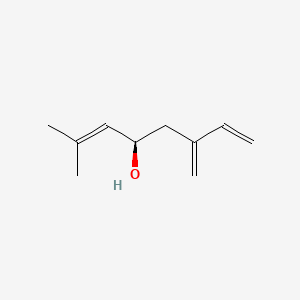| Authors | Title | Published | Journal | PubMed Link |
|---|---|---|---|---|
| Miller DR et al. | Trap lure blend of pine volatiles and bark beetle pheromones for Monochamus spp. (Coleoptera: Cerambycidae) in pine forests of Canada and the United States. | 2013 | J. Econ. Entomol. | pmid:24020282 |
| Figueroa-Teran R et al. | Ipsdienol dehydrogenase (IDOLDH): a novel oxidoreductase important for Ips pini pheromone production. | 2012 | Insect Biochem. Mol. Biol. | pmid:22101251 |
| Allison JD et al. | Role of ipsdienol, ipsenol, and cis-verbenol in chemical ecology of Ips avulsus, Ips calligraphus, and Ips grandicollis (Coleoptera: Curculionidae: Scolytinae). | 2012 | J. Econ. Entomol. | pmid:22812131 |
| Schorkopf DL et al. | Enantioselective preference and high antennal sensitivity for (-)-Ipsdienol in scent-collecting male orchid bees, Euglossa cyanura. | 2011 | J. Chem. Ecol. | pmid:21863327 |
| Miller DR et al. | Bark beetle pheromones and pine volatiles: attractant kairomone lure blend for longhorn beetles (Cerambycidae) in pine stands of the southeastern United States. | 2011 | J. Econ. Entomol. | pmid:21882689 |
| Shumate AM et al. | Disruptive selection maintains variable pheromone blends in the bark beetle Ips pini. | 2011 | Environ. Entomol. | pmid:22217770 |
| Miller DR and Allison JD | Variation in enantiospecific attraction of Ips avulsus (Coleoptera: Curculionidae) to the pheromone ipsdienol in Georgia. | 2011 | J. Econ. Entomol. | pmid:21735909 |
| Zhang QH et al. | Aggregation pheromone of the Qinghai spruce bark beetle, Ips nitidus eggers. | 2009 | J. Chem. Ecol. | pmid:19408044 |
| Sandstrom P et al. | Myrcene hydroxylases do not determine enantiomeric composition of pheromonal ipsdienol in Ips spp. | 2008 | J. Chem. Ecol. | pmid:19034575 |
| Raffa KF et al. | Can chemical communication be cryptic? Adaptations by herbivores to natural enemies exploiting prey semiochemistry. | 2007 | Oecologia | pmid:17618465 |
| Zhang QH et al. | Electrophysiological and behavioral responses of Ips subelongatus to semiochemicals from its hosts, non-hosts, and conspecifics in China. | 2007 | J. Chem. Ecol. | pmid:17216361 |
| Sandstrom P et al. | Functional expression of a bark beetle cytochrome P450 that hydroxylates myrcene to ipsdienol. | 2006 | Insect Biochem. Mol. Biol. | pmid:17046597 |
| Domingue MJ et al. | Genetic control of the enantiomeric composition of ipsdienol in the pine engraver, Ips pini. | 2006 | J. Chem. Ecol. | pmid:16739020 |
| Miller DR and Asaro C | Ipsenol and ipsdienol attract Monochamus titillator (Coleoptera: Cerambycidae) and associated large pine woodborers in southeastern United States. | 2005 | J. Econ. Entomol. | pmid:16539130 |
| Miller DR et al. | Attraction of southern pine engravers and associated bark beetles (Coleoptera: Scolytidae) to ipsenol, ipsdienol, and lanierone in southeastern United States. | 2005 | J. Econ. Entomol. | pmid:16539133 |
| pmid: |
R-ipsdienol
R-ipsdienol is a lipid of Prenol Lipids (PR) class.
